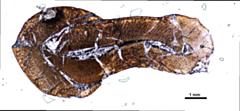Project 3127: C. T. Griffin, L. S. Bano, A. H. Turner, N. D. Smith, R. B. Irmis, S. J. Nesbitt. 2019. Integrating gross morphology and bone histology to assess skeletal maturity in early dinosauromorphs: new insights from Dromomeron (Archosauria: Dinosauromorpha). PeerJ. 7:e6331.
Abstract
Understanding growth patterns is central to properly interpreting paleobiological signals in tetrapods, but assessing skeletal maturity in some extinct clades may be difficult when growth patterns are poorly constrained by a lack of ontogenetic series. To overcome this difficulty in assessing the maturity of extinct archosaurian reptiles—crocodylians, birds and their extinct relatives—many studies employ bone histology to observe indicators of the developmental stage reached by a given individual. However, the relationship between gross morphological and histological indicators of maturity has not been examined in most archosaurian groups. In this study, we utilize a hypothesized growth series of Dromomeron romeri femora (96.6–144.4 mm long), a first among non-dinosauriform dinosauromorphs, to sample both gross morphology and bone histology across the growth series. Previous studies reported that Dromomeron romeri lacks well-developed rugose muscle scars that appear during ontogeny in closely related dinosauromorph taxa, so integrating gross morphology and histological signal is needed to determine reliable maturity indicators for early bird-line archosaurs. We found that, although there are small, linear scars indicating muscle attachment sites across the femur, the only rugose muscle scar that appears during ontogeny is the attachment of the M. caudofemoralis longus, and only in the largest-sampled individual. This individual is also the only femur with histological indicators that asymptotic size had been reached, although smaller individuals possess some signal of decreasing growth rates (e.g., decreasing vascular density). The overall femoral bone histology of Dromomeron romeri is similar to that of other early bird-line archosaurs (e.g., woven-bone tissue, vascular density, longitudinal vascular canals). All these data indicate that the lack of well-developed femoral scars is autapomorphic for this species, not simply an indication of skeletal immaturity. We found no evidence of the high intraspecific variation present in early dinosaurs and other dinosauriforms, but a limited sample size of other early bird-line archosaur growth series makes this tentative. The evolutionary history and phylogenetic signal of gross morphological features must be considered when assessing maturity in extinct archosaurs and their close relatives, and in some groups corroboration with bone histology or better-known morphological characters is necessary.Read the article »
Article DOI: 10.7717/peerj.6331
Project DOI: 10.7934/P3127, http://dx.doi.org/10.7934/P3127
| This project contains |
|---|
Download Project SDD File |
Currently Viewing:
MorphoBank Project 3127
MorphoBank Project 3127
- Creation Date:
06 March 2018 - Publication Date:
27 December 2018 - Media downloads: 2

This research
supported by
Authors' Institutions ![]()
- University of Utah
- Virginia Tech (Virginia Polytechnic Institute and State University)
- Natural History Museum of Los Angeles County
- Stony Brook University
Members
| member name | taxa |
specimens |
media |
| Chris Griffin Project Administrator | 1 | 3 | 17 |
Project has no matrices defined.
Project downloads 
| type | number of downloads | Individual items downloaded (where applicable) |
| Total downloads from project | 191 | |
| Project downloads | 189 | |
| Media downloads | 2 | M480254 (1 download); M480247 (1 download); |

